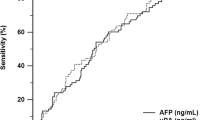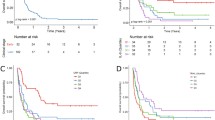Abstract
Background
Urinary trypsin inhibitor (UTI), produced in the liver, has been considered to suppress inflammation. The production of UTI may decrease after a hepatectomy and thereby increase the incidence of postoperative inflammation. This study investigated whether the changes in the UTI level affected the postoperative course in patients undergoing a hepatectomy for hepatocellular carcinoma (HCC). The prognostic significance of UTI was also analyzed.
Methods
The perioperative plasma UTI was measured in 25 HCC patients who underwent hepatic resection, and the correlation between the kinetics of UTI and clinicopathological factors was investigated. The expression of UTI in the resected specimens was examined by immunohistochemistry in 65 patients. Expression of UTI in the cancer cells were then correlated to both the liver pathology and the clinical outcomes in the corresponding patients.
Results
The plasma UTI level greatly decreased on the first postoperative day. This decrease significantly correlated with the resected tumor volume (r s = −.530, P = .006), but it had no influence on inflammatory complications. Immunohistochemistry revealed UTI expression in both noncancerous and cancerous lesions. An overexpression of UTI in HCC tissue was found to be an independent prognostic factor for early recurrence (P = .006).
Conclusions
Although UTI plasma levels were noted to decrease after the removal of an HCC tumor, this decrease did not lead to an increase in inflammatory complications. However, overexpression of UTI in cancer was found to be a risk factor for tumor recurrence after resection, suggesting that UTI expression may be a useful prognostic marker.






Similar content being viewed by others
References
Benzoni E, Cojutti A, Lorenzin D, et al. Liver resective surgery: a multivariate analysis of postoperative outcome and complication. Langenbecks Arch Surg. 2007;392:45–54.
Zhou L, Rui JA, Wang SB, et al. Outcomes and prognostic factors of cirrhotic patients with hepatocellular carcinoma after radical major hepatectomy. World J Surg. 2007;31:1782–7.
Shimada M, Takenaka K, Fujiwara Y, et al. Risk factors linked to postoperative morbidity in patients with hepatocellular carcinoma. Br J Surg. 1998;85:195–8.
Shulman NR. A proteolytic inhibitor with anticoagulant activity separated from human urine and plasma. J Biol Chem. 1955;213:655–71.
Hirose J, Ozawa T, Miura T, et al. Human neutrophil elastase degrades inter-alpha-trypsin inhibitor to liberate urinary trypsin inhibitor related proteins. Biol Pharm Bull. 1998;21:651–6.
Sato N, Endo S, Kimura Y, et al. Influence of a human protease inhibitor on surgical stress induced immunosuppression. Dig Surg. 2002;19:300–5.
Uemura K, Murakami Y, Hayashidani Y, et al. Randomized clinical trial to assess the efficacy of ulinastatin for postoperative pancreatitis following pancreaticoduodenectomy. J Surg Oncol. 2008;98:309–13.
Ambiru S, Miyazaki M, Sasada K, et al. Effects of perioperative protease inhibitor on inflammatory cytokines and acute-phase proteins in patients with hepatic resection. Dig Surg. 2000;17:337–43.
Kobayashi H, Suzuki M, Kanayama N, et al. Suppression of urokinase receptor expression by bikunin is associated with inhibition of upstream targets of extracellular signal-regulated kinase-dependent cascade. Eur J Biochem. 2002;269:3945–57.
Kobayashi H, Suzuki M, Tanaka Y, Kanayama N, Terao T. A Kunitz-type protease inhibitor, bikunin, inhibits ovarian cancer cell invasion by blocking the calcium-dependent transforming growth factor-beta 1 signaling cascade. J Biol Chem. 2003;278:7790–9.
Yamamoto Y, Ikai I, Kume M, et al. New simple technique for hepatic parenchymal resection using a Cavitron Ultrasonic Surgical Aspirator and bipolar cautery equipped with a channel for water dripping. World J Surg. 1999;23:1032–7.
Liver Cancer Study Group of Japan. General Rules for the Clinical and Pathological Study of Primary Liver Cancer. 2nd English ed. Tokyo: Kanehara, 2003.
Lin SD, Endo R, Sato A, et al. Plasma and urine levels of urinary trypsin inhibitor in patients with acute and fulminant hepatitis. J Gastroenterol Hepatol. 2002;17:140–7.
Jonsson-Berling BM, Ohlsson K, Rosengren M. Radioimmunological quantitation of the urinary trypsin inhibitor in normal blood and urine. Biol Chem Hoppe Seyler. 1989;370:1157–61.
Uchinami H, Seki E, Brenner DA, D’Armiento J. Loss of MMP 13 attenuates murine hepatic injury and fibrosis during cholestasis. Hepatology. 2006;44:420–9.
Tanaka Y, Kobayashi H, Suzuki M, et al. Reduced bikunin gene expression as a factor of poor prognosis in ovarian carcinoma. Cancer. 2003;98:424–30.
Noie T, Sugawara Y, Harihara Y, et al. Kinetics of urinary trypsin inhibitor in patients undergoing partial hepatectomy. Scand J Gastroenterol. 2001;36:410–6.
Yamamoto Y. Liver resection in liver cirrhosis. Chirurg. 2001;72:784–93.
Taura K, Ikai I, Hatano E, et al. Implication of frequent local ablation therapy for intrahepatic recurrence in prolonged survival of patients with hepatocellular carcinoma undergoing hepatic resection: an analysis of 610 patients over 16 years old. Ann Surg. 2006;244:265–73.
Yoshida E, Sumi H, Maruyama M, et al. Distribution of acid stable trypsin inhibitor immunoreactivity in normal and malignant human tissues. Cancer. 1989;64:860–9.
Tanaka Y, Kobayashi H, Suzuki M, et al. Upregulation of bikunin in tumor-infiltrating macrophages as a factor of favorable prognosis in ovarian cancer. Gynecol Oncol. 2004;94:725–34.
Bourguignon J, Borghi H, Sesboue R, et al. Immunohistochemical distribution of inter-alpha-trypsin inhibitor chains in normal and malignant human lung tissue. J Histochem Cytochem. 1999;47:1625–32.
Ogasawara S, Yano H, Momosaki S, et al. Expression of matrix metalloproteinases (MMPs) in cultured hepatocellular carcinoma (HCC) cells and surgically resected HCC tissues. Oncol Rep. 2005;13:1043–8.
Yoshioka I, Tsuchiya Y, Aozuka Y, et al. Urinary trypsin inhibitor suppresses surgical stress–facilitated lung metastasis of murine colon 26-L5 carcinoma cells. Anticancer Res. 2005;25:815–20.
Tsui KH, Chang PL, Feng TH, et al. Down-regulation of matriptase by overexpression of bikunin attenuates cell invasion in prostate carcinoma cells. Anticancer Res. 2008;28:1977–83.
Grondahl-Hansen J, Christensen IJ, Rosenquist C, et al. High levels of urokinase-type plasminogen activator and its inhibitor PAI-1 in cytosolic extracts of breast carcinomas are associated with poor prognosis. Cancer Res. 1993;53:2513–21.
Pappot H, Pedersen AN, Brunner N, Christensen IJ. The complex between urokinase (uPA) and its type-1 inhibitor (PAI-1) in pulmonary adenocarcinoma: relation to prognosis. Lung Cancer. 2006;51:193–200.
Tonouchi A, Ohtsuka M, Ito H, et al. Relationship between pancreatic secretory trypsin inhibitor and early recurrence of intrahepatic cholangiocarcinoma following surgical resection. Am J Gastroenterol. 2006;101:1601–10.
Lee YC, Pan HW, Peng SY, et al. Overexpression of tumour-associated trypsin inhibitor (TATI) enhances tumour growth and is associated with portal vein invasion, early recurrence and a stage-independent prognostic factor of hepatocellular carcinoma. Eur J Cancer. 2007;43:736–44.
Paju A, Vartiainen J, Haglund C, et al. Expression of trypsinogen-1, trypsinogen-2, and tumor-associated trypsin inhibitor in ovarian cancer: prognostic study on tissue and serum. Clin Cancer Res. 2004;10:4761–8.
Wiksten JP, Lundin J, Nordling S, et al. High tissue expression of tumour-associated trypsin inhibitor (TATI) associates with a more favourable prognosis in gastric cancer. Histopathology. 2005;46:380–8.
McKeehan WL, Sakagami Y, Hoshi H, McKeehan KA. Two apparent human endothelial cell growth factors from human hepatoma cells are tumor-associated proteinase inhibitors. J Biol Chem. 1986;261:5378–83.
Perry JK, Scott GK, Tse CA. Modulation of proliferation of cultured human cells by urinary trypsin inhibitor. Biochim Biophys Acta. 1994;1221:145–52.
Umeadi C, Kandeel F, Al-Abdullah IH. Ulinastatin is a novel protease inhibitor and neutral protease activator. Transplant Proc. 2008;40:387–9.
Acknowledgment
This work was partly supported by a grant-in-aid of the Japan Society for the Promotion of Science, Tokyo, Japan (18591497). We thank Dr. Katsuyuki Murata (Department of Environmental Health Sciences, Akita University School of Medicine) for statistical advice.
Author information
Authors and Affiliations
Corresponding author
Rights and permissions
About this article
Cite this article
Kikuchi, I., Uchinami, H., Nanjo, H. et al. Clinical and Prognostic Significance of Urinary Trypsin Inhibitor in Patients with Hepatocellular Carcinoma After Hepatectomy. Ann Surg Oncol 16, 2805–2817 (2009). https://doi.org/10.1245/s10434-009-0622-2
Received:
Revised:
Accepted:
Published:
Issue Date:
DOI: https://doi.org/10.1245/s10434-009-0622-2




